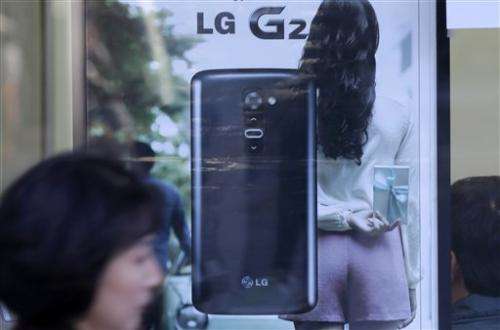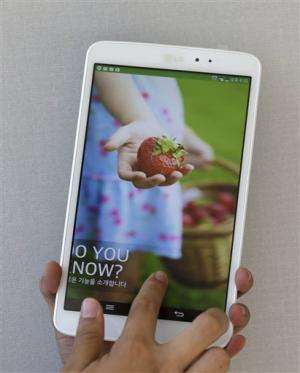Review: Button location sets LG's G2 apart (Update)

LG's flagship mobile gadgets—the G2 smartphone and the G Pad 8.3 tablet—are great mobile devices that have fantastic screens, top-end cameras and ample processing power.
But making an impressive device is not enough to stand apart from the crowd in the ultra-competitive mobile phone market, which probably pushed LG Electronics Inc. to make some bold design decisions in a bid to differentiate its G series from Samsung's Galaxy line and Apple's iPad Mini.
For the G2, which was released last month in the U.S., LG moved the power and volume controls to the back of the phone. For the G Pad, which goes on sale in the U.S. next week, LG added a full HD screen. The resolution on the G Pad's 8.3 inch screen, measured diagonally, is better than what's on Samsung's Galaxy Note 8.0 and Apple's iPad Mini, though Apple is expected to refresh its lineup next week. Slightly smaller, 7-inch tablets from Google and Amazon have full HD screens comparable to LG's.
LG's design choices set the G2 and the G Pad apart from "me, too" devices trying to catch up with Samsung and Apple, but they might also limit their appeal.
Not everyone will be pleased with having to change the basic habits of smartphone operation. They will scratch their heads looking for those buttons just as I did.
It took a couple of days before my index finger ceased pressing a volume key when I intended to press a power key. But after that, I realized having a power button on the back makes it easier to use a big handset with one hand. The G2 has a 5.2-inch screen.

LG came up with a double-tap gesture to activate the phone. I found it easier and quicker than pressing a home button and then sliding to unlock as with my iPhone 4S. This double-tap to start also applies to the G Pad.
LG removed the physical home button on the front for the G2 and the G Pad. Instead, virtual buttons for back, home and menu actions appear when the screen is activated. I preferred these virtual buttons over physical ones because I could touch them with the same gesture and pressure I applied to the touch screen. One downside of Samsung's Galaxy devices is that the touch screen and the three buttons for home, back and menu options all need a different level of pressure to be activated.
LG's virtual buttons rotated with the screen when I tilted the G2 or the G Pad to a horizontal, landscape mode. That made them easy to access when I watched a movie in the landscape mode with the G Pad. Removing the physical home button also gives the screen more space in the phone.
But the design elements that make the G2 and the G Pad different from rivals stopped there.
LG has packed the G2 with other features, but many of them were no better than what is already available. For example, a feature called Task Slider allows multitasking by swiping the screen with three fingers to hide or reopen an application. But Android users are familiar with an extended press of the home button to bring up a list of applications in use, which is quick and more intuitive.
The G2 will be a great choice, but only for people who don't mind re-learning how to use a smartphone. In the U.S., the G2 smartphone is available at $200 with a two-year service contract or $600 without a contract from a carrier.
While the U.S. price has yet to be announced for the G Pad, the tablet is offered at 550,000 won ($515) in South Korea. By contrast, the iPad Mini sells for $329 in the U.S., and the retail price for the Note is $400. That full HD display makes the G Pad a couple of hundred dollars more expensive than other 8-inch tablets. It's a decent choice—for those willing to pay for the better screen.
© 2013 The Associated Press. All rights reserved.





















